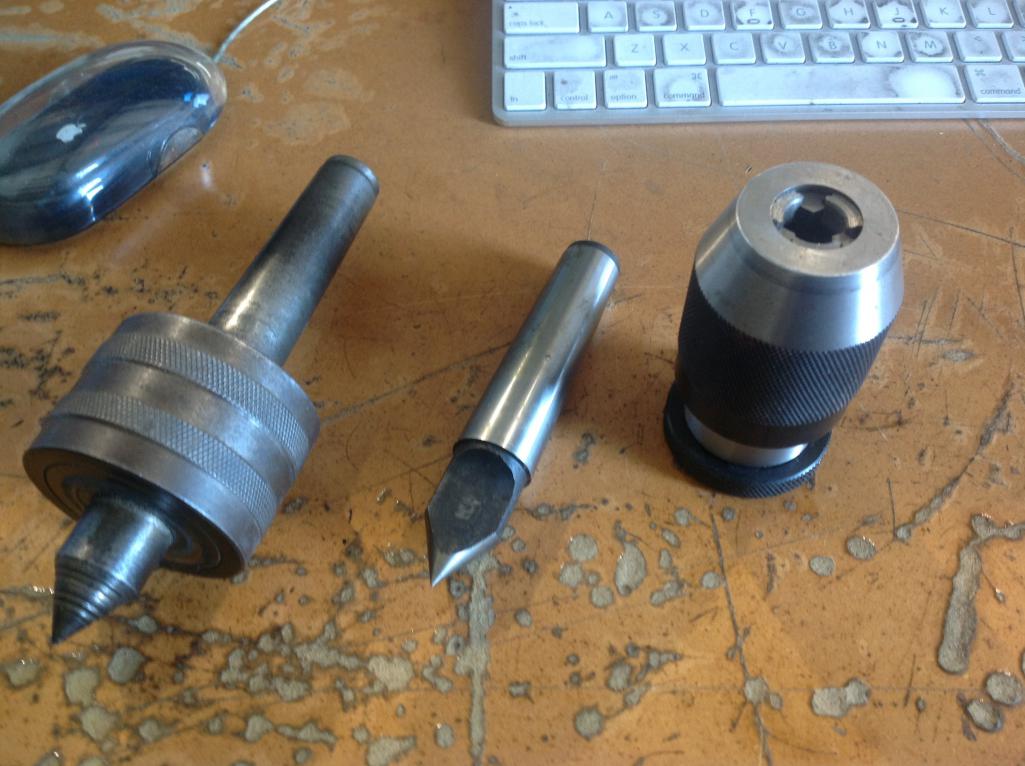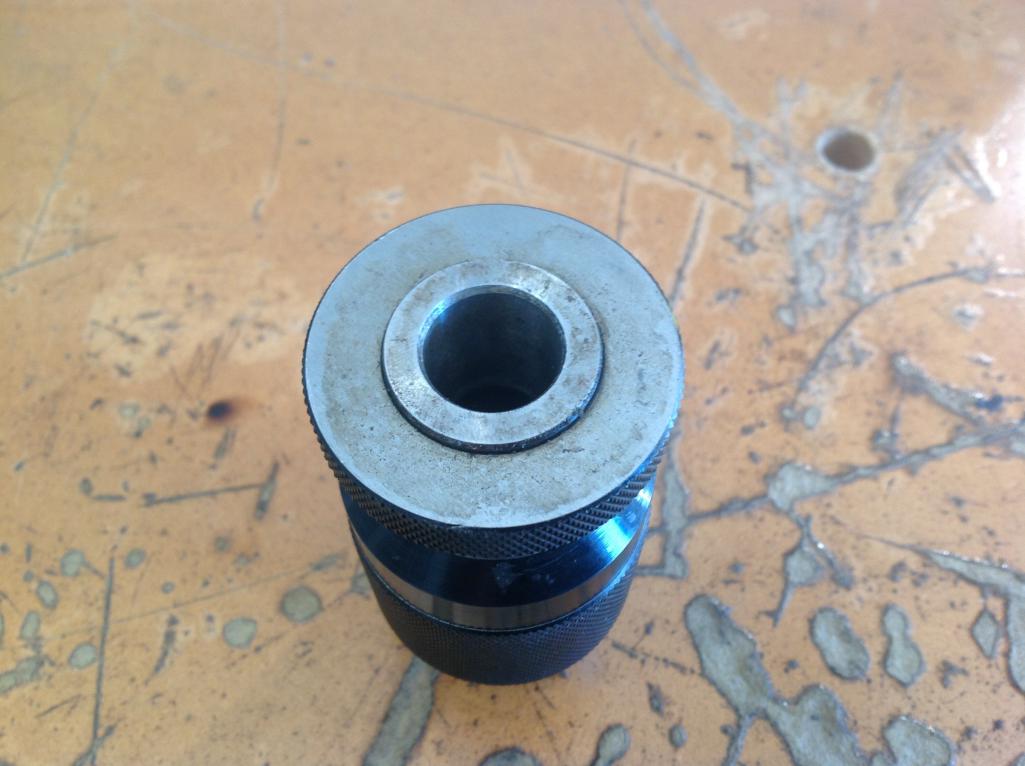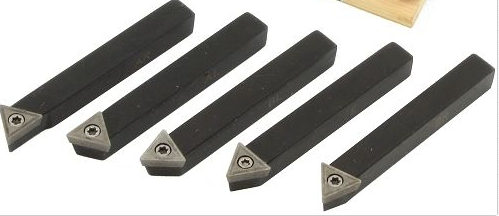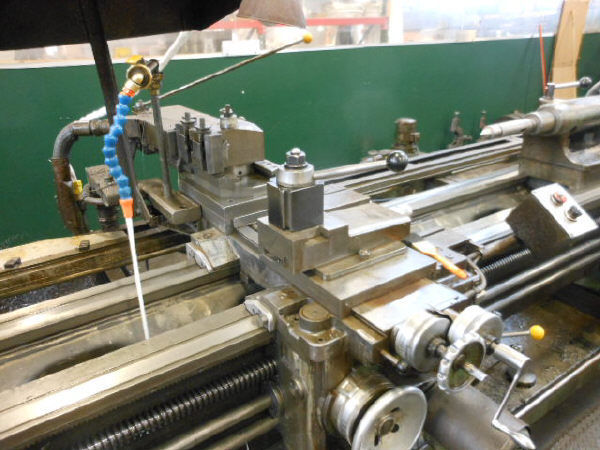|
|

|
Porsche, and the Porsche crest are registered trademarks of Dr. Ing. h.c. F. Porsche AG.
This site is not affiliated with Porsche in any way. Its only purpose is to provide an online forum for car enthusiasts. All other trademarks are property of their respective owners. |
|
|
  |
| Darren C |
 Feb 17 2016, 04:04 PM Feb 17 2016, 04:04 PM
Post
#113
|
|
Member   Group: Members Posts: 392 Joined: 26-December 14 From: Chichester UK Member No.: 18,255 Region Association: England |
Not bad attempt there Joe,
Watch the outside diameter. Original bushes are precision ground to a fine micron finish where the lip seal runs. A turned finish using a HSS tool with coolant will not be good enough. It'll wear the lip seal within a few miles and your brake hub will be full of oil. |
| Series9 |
 Feb 17 2016, 04:43 PM Feb 17 2016, 04:43 PM
Post
#114
|
|
Lesbians taste like chicken.      Group: Members Posts: 5,444 Joined: 22-August 04 From: DeLand, FL Member No.: 2,602 Region Association: South East States |
Not bad attempt there Joe, Watch the outside diameter. Original bushes are precision ground to a fine micron finish where the lip seal runs. A turned finish using a HSS tool with coolant will not be good enough. It'll wear the lip seal within a few miles and your brake hub will be full of oil. After that amount of time at the lathe, we are not calling this an "attempt". I polished it before installation. We'll see how it goes. At least the brakes work correctly and the axles turn smoothly. I'm looking into carbide and ceramic bits. I would definitely like to turn something that comes out like it was polished in the lathe. I did discover that turning slowly works better for larger bites during the rough process, and spinning the piece quickly for a light pass produces a nicer finish. |
| r_towle |
 Feb 17 2016, 05:10 PM Feb 17 2016, 05:10 PM
Post
#115
|
|
Custom Member                Group: Members Posts: 24,632 Joined: 9-January 03 From: Taxachusetts Member No.: 124 Region Association: North East States 
|
I think the clock is really the first production piece
|
| Series9 |
 Feb 17 2016, 08:16 PM Feb 17 2016, 08:16 PM
Post
#116
|
|
Lesbians taste like chicken.      Group: Members Posts: 5,444 Joined: 22-August 04 From: DeLand, FL Member No.: 2,602 Region Association: South East States |
I think the clock is really the first production piece It's not yet a clock and it doesn't contribute to the operation of anything. It is simply a reminder to me that the lathe is much more complicated than it appears. (IMG:style_emoticons/default/beerchug.gif) |
| r_towle |
 Feb 17 2016, 09:27 PM Feb 17 2016, 09:27 PM
Post
#117
|
|
Custom Member                Group: Members Posts: 24,632 Joined: 9-January 03 From: Taxachusetts Member No.: 124 Region Association: North East States 
|
Well, keeping time is important.
I think it's pretty cool you made a custom part for a client, well done go have a beer |
| Series9 |
 Feb 18 2016, 09:15 AM Feb 18 2016, 09:15 AM
Post
#118
|
|
Lesbians taste like chicken.      Group: Members Posts: 5,444 Joined: 22-August 04 From: DeLand, FL Member No.: 2,602 Region Association: South East States |
Here are my tail stock parts. I don't see a way to mount the drill chuck. Is this called a Morse Taper? What size is it? I need to find the piece to mount the chuck in the tail stock. Attached thumbnail(s) 
|
| nathansnathan |
 Feb 18 2016, 10:15 AM Feb 18 2016, 10:15 AM
Post
#119
|
|
Senior Member    Group: Members Posts: 1,052 Joined: 31-May 10 From: Laguna Beach, CA Member No.: 11,782 Region Association: None |
You need an arbor that goes from morse taper to jacobs taper probably. Looks like morse taper 3 from here. Here's a link to some dimensions you can check to be sure
http://littlemachineshop.com/reference/tapers.php Some chucks are threaded, too, though. here's the page at mcmaster-carr http://www.mcmaster.com/#drill-chuck-arbors/=116h0wj |
| r_towle |
 Feb 18 2016, 10:48 AM Feb 18 2016, 10:48 AM
Post
#120
|
|
Custom Member                Group: Members Posts: 24,632 Joined: 9-January 03 From: Taxachusetts Member No.: 124 Region Association: North East States 
|
threaded chuck?
Rich |
| Series9 |
 Feb 18 2016, 02:29 PM Feb 18 2016, 02:29 PM
Post
#121
|
|
Lesbians taste like chicken.      Group: Members Posts: 5,444 Joined: 22-August 04 From: DeLand, FL Member No.: 2,602 Region Association: South East States |
Attached thumbnail(s) 
|
| Series9 |
 Feb 18 2016, 02:56 PM Feb 18 2016, 02:56 PM
Post
#122
|
|
Lesbians taste like chicken.      Group: Members Posts: 5,444 Joined: 22-August 04 From: DeLand, FL Member No.: 2,602 Region Association: South East States |
It looks like the tail stock is an MT3. The numbers don't match the chart exactly, but pretty close.
The drill chuck, however, doesn't really match any of it. It does appear to have a taper that's about 1" long and about .670" at the big end. |
| Darren C |
 Feb 18 2016, 03:07 PM Feb 18 2016, 03:07 PM
Post
#123
|
|
Member   Group: Members Posts: 392 Joined: 26-December 14 From: Chichester UK Member No.: 18,255 Region Association: England |
From the pictures it looks like you need a Morse to Jacobs taper spindle as Nathan also thought.
My advice is swap the chuck for one that takes a Jacobs key. The self locking chuck like you have are great in a hand drill, not so good in a lathe. You cant tighten them up very well and then they can "work-lock" and then you cant get the darn things undone. |
| nathansnathan |
 Feb 18 2016, 03:14 PM Feb 18 2016, 03:14 PM
Post
#124
|
|
Senior Member    Group: Members Posts: 1,052 Joined: 31-May 10 From: Laguna Beach, CA Member No.: 11,782 Region Association: None |
Sounds to me like mt3 to jt6, which is "2811A37" part number at mcmaster.
(IMG:http://www.914world.com/bbs2/uploads_offsite/images1.mcmaster.com-11782-1455830079.1.png) |
| Series9 |
 Feb 18 2016, 04:42 PM Feb 18 2016, 04:42 PM
Post
#125
|
|
Lesbians taste like chicken.      Group: Members Posts: 5,444 Joined: 22-August 04 From: DeLand, FL Member No.: 2,602 Region Association: South East States |
From the pictures it looks like you need a Morse to Jacobs taper spindle as Nathan also thought. My advice is swap the chuck for one that takes a Jacobs key. The self locking chuck like you have are great in a hand drill, not so good in a lathe. You cant tighten them up very well and then they can "work-lock" and then you cant get the darn things undone. I think I agree with that. This chuck looks and feels really nice, but there are no numbers on it (I mean no identifying marks of any sort) and it might be good for light duty work, but I can see how it could get stuck. Shopping for MT3 keyed tail chuck.... |
| Mueller |
 Feb 18 2016, 04:44 PM Feb 18 2016, 04:44 PM
Post
#126
|
|
914 Freak!                Group: Members Posts: 17,150 Joined: 4-January 03 From: Antioch, CA Member No.: 87 Region Association: None 
|
Nice, making chips and a part for a project car even better!
|
| Porsche930dude |
 Feb 18 2016, 09:15 PM Feb 18 2016, 09:15 PM
Post
#127
|
|
Member   Group: Members Posts: 399 Joined: 25-November 11 From: Vestal NY Member No.: 13,819 Region Association: None |
my brother just got a little 6" atlas . its smaller than he wanted but it was cheap. he rebuilt it and is starting to make stuff now. he's been watching utube videos for years so he knows alot. weve been melting aluminum down and making soup can ingots to turn down into stuff. he already made a 4 slot pulley that the lathe was missing now he is going to attempt to make some gears that its missing. He hasnt tried turning steel yet I think hes a little afraid
|
| Darren C |
 Feb 19 2016, 02:01 AM Feb 19 2016, 02:01 AM
Post
#128
|
|
Member   Group: Members Posts: 392 Joined: 26-December 14 From: Chichester UK Member No.: 18,255 Region Association: England |
my brother just got a little 6" atlas . its smaller than he wanted but it was cheap. he rebuilt it and is starting to make stuff now. he's been watching utube videos for years so he knows alot. weve been melting aluminum down and making soup can ingots to turn down into stuff. he already made a 4 slot pulley that the lathe was missing now he is going to attempt to make some gears that its missing. He hasnt tried turning steel yet I think hes a little afraid 40 years ago when I was at school my metalshop teacher (who inspired me to go into engineering) said to the class... "The lathe is the only machine created by the hand of man that can reproduce itself" I went on to build my own lathe between age 14 & 16 as my project for my "o level in mechanical engineering workshop theory & practice" I made the headstock, tailstock and carriage in wood, cast it in aluminium using sand boxes and then used the school lathe as a mill. I turned everything, I made the chuck, lead screw, saddles, tool holders...absolutely everything. It was about a 3ft long when finished and powered by clamping in a hand drill into the basic gear box that I'd made. Very crude looking back; but hey I was only a kid making his first lathe. |
| Series9 |
 Feb 19 2016, 07:53 AM Feb 19 2016, 07:53 AM
Post
#129
|
|
Lesbians taste like chicken.      Group: Members Posts: 5,444 Joined: 22-August 04 From: DeLand, FL Member No.: 2,602 Region Association: South East States |
Will someone explain the different uses for these different angles?
Attached image(s) 
|
| Darren C |
 Feb 19 2016, 08:32 AM Feb 19 2016, 08:32 AM
Post
#130
|
|
Member   Group: Members Posts: 392 Joined: 26-December 14 From: Chichester UK Member No.: 18,255 Region Association: England |
It’s all to do with available clearance between what your turning and the position of components of the lathe.
Most standard tip tools are design to sit in one position (90 degrees to the lathe centre) in this normal position the angle of the tip is optimised to turn down or face off. If you have a rotating tool post you can fit several tools and spin it in 90 degree increments to change between say a parting off tool and a facing off tool. The clamp mechanism allows a small say 10 degree misalignment from North, East, South, West positions where you can clamp it correctly. However if you try and set it a 45 degrees (NE) for example, the clamp device doesn’t lock correctly and the tool will be off Height. It’s always good practice with a tip tool (particularly with radius end tools) to change the angle slightly between jobs so that it’s not cutting on the same point all the time. Different finishes can be achieved with different tool angles. (These are angles in the horizontal plane and can be described as angle of attack) Different angles in the vertical plane (called “Rake”) come into play with HSS tools especially with differing materials. On a soft material such as aluminium you need a larger rake angle than for steel. Large radius ended tools of HSS are commonly used for a fine smooth shiny finish Tipped ceramic tools tend to be pre manufactured by material type where best speed and material are specified. This begins to get complicated when you adjust the tool slide to produce tapers or to reach around the job to gain access to turn awkward shapes, turn with the lathe spinning in reverse or Left hand turn. That’s why you can buy tools with various position tips in the holder. It’s to optimise the angle of attack that the tip of the tool makes contact with the job under various positions and types of RH or LH turning where the tool post angle is not at 90 degrees to lathe centre. That said some angles of attack vary dependent on the material they are designed for in addition to having differing rakes. All of this means nothing if you don’t have the correct speed and feed for the material. Looking at the photo from left to right; the 6 tools run RH, LH, LH, Universal, RH Hope this is of help. |
| Series9 |
 Feb 20 2016, 04:43 PM Feb 20 2016, 04:43 PM
Post
#131
|
|
Lesbians taste like chicken.      Group: Members Posts: 5,444 Joined: 22-August 04 From: DeLand, FL Member No.: 2,602 Region Association: South East States |
Good information. Thank you.
I think I understand angle of attack, but I need more on rake. While I understand the rake plane, what is an example of zero rake vs high rake? Does the tool always intersect the piece at the 270 degree point in the rotation? (270 being the point that represents west if you look at the chuck end-on). Also, when you say Right-hand and Left-hand, is that a reference to the direction the tool is moving against the piece or the direction the piece is spinning in the lathe? I'm under the assumption that almost everything is turned in a CCW direction at the chuck. |
| veekry9 |
 Feb 20 2016, 08:14 PM Feb 20 2016, 08:14 PM
Post
#132
|
|
OldMember     Group: Retired Members Posts: 3,068 Joined: 17-June 13 From: TO Member No.: 16,025 Region Association: Canada |
https://www.youtube.com/watch?v=vAo0xmDQ-kI https://www.google.ca/#q=turning++4130+shaft https://www.google.ca/search?q=turning+4340...bEaDPIQ_AUIBigB http://www.weldingtipsandtricks.com/welding-4130.html Machining Fundamentals https://www.google.ca/search?q=Machining+Fu...EM_xr18tvY8M%3A The design of the lathe makes the CCW rotation load the the toolpost and carriage in compression.(pushing down) For similar CW loads a secondary toolpost can be installed on the other side of the CL. As an example,during the '70s while using VDF engine lathes,a shaft similar to the one in the ytub above was ruf turned in conventional ccw rotation using all 6 corners of the indexing toolpost,heavy production turning. http://www.carboloy.com/company.html Subsequently,the final finishing passes were turned with a cw rot and the hydraulic tracing attachment installation,whereby the carriage radius was servo controlled. A 1:1 scale template was held in sync with the actual shaft and guided the rear crosslide with several paths to the correct dimensions. The point of all this is that every year since,there has been progress in materials and methods and a steep learning curve is needed to 'bone up'. Basic,elementary concepts are easily available freely,worthwhile study for the proper use of the machinery. A horror story: In 1979 a recently purchased cnc mill was programmed to zig instead of zag by an error of polarity,negative,not positive. The 7/8" drill in the spindle,about a foot long,snapped off at the shank and struck the operator,the shop owner,between the eyes at the bridge of his nose. He fell to one knee,hand over his face then staggered to his feet,a golf ball sized lump swelling on his face. I got him an emergency ice pack from the freezer,and he left for a few days off. What I mean is,is that even expert machinists make mistakes,had the broken drill penetrated his eye,it would have been fatal. The energy needed to break the drill and travel the 20-30 feet after striking him,was from the rapid travel rate of the mill and the M42 steel strength of the drill. Prepare yourself for the proper use of machine tools,period. Exercise caution and due diligence and read the manuals,warnings and safety notices. Never run the machine without safety glasses or masks. Never. / ref. http://www.ebay.com/itm/20-x-157-VDF-S500-...wAAAOSwstxVQ8sM  20__x_157__VDF__S500__Engine_Lathe_w_Tracer_Attachment_27503___eBay.html ( 248.74k )
Number of downloads: 399
20__x_157__VDF__S500__Engine_Lathe_w_Tracer_Attachment_27503___eBay.html ( 248.74k )
Number of downloads: 399 https://www.google.ca/webhp?sourceid=chrome...dit+II+cnc+mill https://www.google.ca/search?q=lathe+tool+g...-lXnx3BrxfKM%3A http://www.metalsdepot.com/catalog_cart_view.php?msg= http://www.ingersoll-imc.com/en/index.htm https://www.google.ca/search?q=carbide+inse...gB&dpr=1.75 / The industry is so vast that learning the right question is in order. The grinding of HSS and brazed carbide tools is a whole subject in itself,safety paramount. Learning to sharpen drill bits to a tested standard is a part of a machine trade training course. Turning a simple shaft to +/-0.0003 was demonstrated,the experience evident. Simple errors would get it wrong and useless,making scrap for double or triple loss. Safety errors cost more than money. (IMG:style_emoticons/default/unsure.gif) / https://www.youtube.com/watch?v=otifkak5RMA / Good stories of success by innovation and effort. Just when you think you learned something new,something new must be learned. The RH,LH refers to the offset of the tool's shank,ie:a left moving tool has a RH offset shank. http://www.cmsna.com/blog/2013/01/history-...ncept-was-born/ http://www.practicalmachinist.com/vb/cnc-m...er-tape-174794/ https://www.cncci.com/resources/tips.htm http://www.fadalvmcparts.com/history.html http://www.haascnc.com/home.asp#gsc.tab=0 http://www.heidenhain.com/en_US/products-a...s/cnc-controls/ http://www.fanucamerica.com/ http://w3.siemens.com/mcms/mc-systems/en/a...k-controls.aspx http://www.toshiba-machine.com/departmentlanding.aspx?dept=2 http://www.fidia.it/en/prodotti_en.htm http://www.selca.it/index.php?id=selca http://www.gruppoparpas.com/products.aspx http://www.fptindustrie.com/en/products/boring_machines/3/ https://cache.industry.siemens.com/dl/files...13_en_en-US.pdf https://cache.industry.siemens.com/dl/files...annig_Guide.pdf Information Overload. There is so much data to absorb,a small step approach can be effective.Training is crucial,if only for the safety lessons. Buy a programmable calculator to do the formulas for feeds/speeds/hp/ruf-rms/,just to be in the ballpark,on the same page. https://www.google.ca/search?q=programmable...SUw0c1UIRqdM%3A An actual 'real' tool grinder is needed to prepare hss or brazed carbide tools for turning,with the correct abrasive wheels. Learning of the proper terminology and functions of the lathe controls and components is step #1. Cutting rates are the next subject,tool geometry the next after that and so on. / http://www.cnccookbook.com/MTCNCDictDeflecttoFollow.htm A good single source of info,handy helpful references for machining. / |
  |
1 User(s) are reading this topic (1 Guests and 0 Anonymous Users)
0 Members:

|
Lo-Fi Version | Time is now: 5th October 2024 - 01:47 PM |
Invision Power Board
v9.1.4 © 2024 IPS, Inc.








